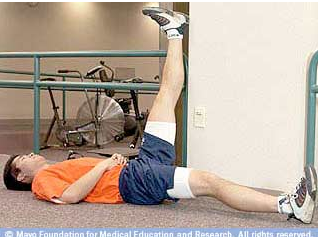Lesson 1 - What Rebounding does for our body
I often receive phone calls from my clients after they have actively used their rebounder for about three weeks. They share with me the amazing results they get from rebounding. I love those phone calls! But how can it be that within only two to three weeks of moderate exercising, your body can shift so much? When I started rebounding, it took me only two weeks of 20 minutes of daily rebounding to bring a significant change of toning to my body. And this without any heavy duty workouts, just nice moderate rebounding exercises - the one I am going to teach you in the Foundation Training. The video below shows you why Rebounding is so efficient for your body. |
| |||||||||
|
Lesson 3 -
Correct feet positioning on a rebounder
The correct feet positioning in rebounding is of utmost importance. If our feet are incorrectly aligned, we can hurt ourselves. This is true for our daily life - walking on a hard surface - and it is even truer when we are standing on a soft surface, like the mat of a rebounder. A common misconception is that a rebounder can make you pronate. A rebounder can never make you pronate. You either pronate or you don't. And if you pronate, you do this in your daily walking, too. The Rebounder acts here like a magnifying glass and shows you a habit that you have. It is very helpful to change this habit as it is not healthy to pronate in daily life. It is your muscles in the feet that hold your feet in the correct position. If these muscles are weak, you can train them. In most cases you just have to consciously put your feet in a 90% angle towards the floor (or the Rebounder mat) and this is all it needs Assignment for today: Watch both video clips below and apply the teachings to your rebounding. |
During a rebounding sequence, if you cannot constantly think of correct feet positioning, use the first two and the last two minutes to apply what you have learned in the video. Ideally you do that barefoot on your rebounder (or in socks that don't slip). For the remaining minutes of your rebounding sequence, do your normal routine. If you have heavy problems with pronation, wear your orthotics in your sneakers while rebounding. Very important: Don't be hard on yourself when trying to align your heel bone to a 90 degree angle to the mat! It is important that you are not stiffening up. The vertical movement ALWAYS needs to go through the entire body, without being blocked by stiffening up. It is the goal to get the heel to 90 degrees to the mat, and this might be a process which takes time - because you have to change a habit! So don't force it. Make sure that you relax the ankles in the upper part of your bounce. That is at least as important as paying attention that your heel bone is in a 90 degree angle to the mat in the down bounce. Don't sacrifice the one for the other! |
|
Lesson 4
Correct alignment on the rebounder.
How to use a Theraband for balance.
The Health bounce.
In this session, we will put into practice what we have learned before: Working on proper alignment on our rebounder! Assignment: Apply the alignment work to all your rebounding today: Before going into your rebounding routine, make sure that you apply what you have learned today. You might need to slow down a bit for that. Recommendation: If proper alignment is very new to you and if you rebound more than 10 minutes per session, apply it for the first 3 minutes of your rebounding, then do your normal routine, and then the last 3 minutes of your rebounding, make again sure that you apply the correct rebounding technique. Like that you can still get your "workout" in. |
Lesson 5
Exercise "Propeller"
In this session,I will show you an invigorating exercise. It is called "The propeller". It is a great way to strengthen your arms and at the same time it helps pumping oxygen into your body. Have fun! |
Lesson 6
- Rebounding - How much? How often?
Have you heard the phrase "Sitting is the new smoking?" That's because numerous scientific research has confirmed that our body needs movement. And not just one time per day. In order to function 'ok' - not a 'nice to have', just to function 'ok', our body needs us to do at least 5000 steps per day. |
Below you find links to free download of applications that help you remind yourself
that it's time to rebound:
Get your movement in today! with our 3 -Minute Energy Boost Routine:
Lesson 7
The difference between Trampolining and Rebounding
- Body alignment
The three types of Rebounding:
parallel / alternating / cross-country
We soon arrive at the end of Part 1 of our Foundation Class and in this session I am teaching you the three different types of Rebounding: "Parallel, alternating and cross country". Those movements are the basis for our exercises which you will learn in the continuation of this Foundation Class. |
|



